The Chuwi LapBook 14.1 Review: Redefining Affordable
by Brett Howse on March 10, 2017 8:00 AM ESTSystem Performance
With the preamble out of the way, let’s dig into just how this new Apollo Lake platform does perform. The Chuwi LapBook 14.1 features the Intel Celeron N3450, which is a quad-core CPU, which runs between 1.1 GHz and 2.2 GHz. There is no Hyperthreading available. There is 4 GB of memory, and Intel HD graphics 500, which is Gen 9 graphics with 12 execution units. The GPU runs between 200 MHz and 700 Mhz. With a 6 W TDP, and 4 W SDP, there is no fan required.
To measure performance, the LapBook was run through our typical set of tests, and for comparison several other devices were selected to get a good representation of where the LapBook fits in. The HP Stream 11 is the Celeron N2840, which is a dual-core Bay Trail-M offering, and when it was tested it was $199. The 2017 model is still a dual-core, but Braswell based with the N3050, so the LapBook should have a big advantage with twice as many cores.
We don’t get a lot of less expensive devices, so we’ll also see the ASUS UX305, which features a Broadwell based Core M 5Y10, and Lenovo Yoga 3 Pro with Core M 5Y71, for comparison to a slightly older 4.5-Watt Core M part. Also, the Microsoft Surface 3 features the fastest Cherry Trail Atom x7 available at that time, which is a quad-core Airmont part, but with a 2-Watt SDP. The Razer Blade Stealth is a thin and light 15-Watt Core product, and although it’s quite a bit more expensive, it’s a good comparison for a modern Ultrabook performance versus the latest Atom. Finally, I’ve selected the Acer Aspire S3, which is an older Core i7-2637M processor, to see how the latest Atom fares against older Core, and the Acer Aspire S7 with Haswell Core i7-4500U. Clearly, the HP Stream 11 will be the most relevant comparison, but since we get so few of these low-end devices in, it will be good to see where they fit, especially if you are thinking of replacing an older notebook. We don’t have full results for some of the older devices, since testing methodology changes over the years, but if you’d like to compare the Chuwi LapBook 14.1 against any other device we’ve tested, please check out our online Bench.
PCMark
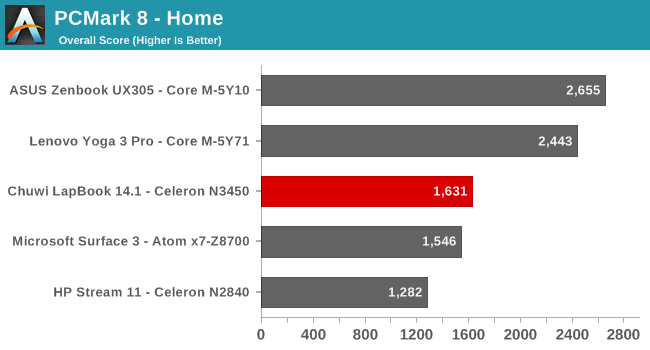
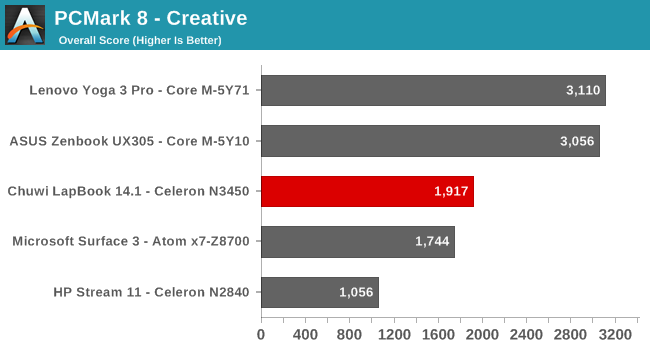
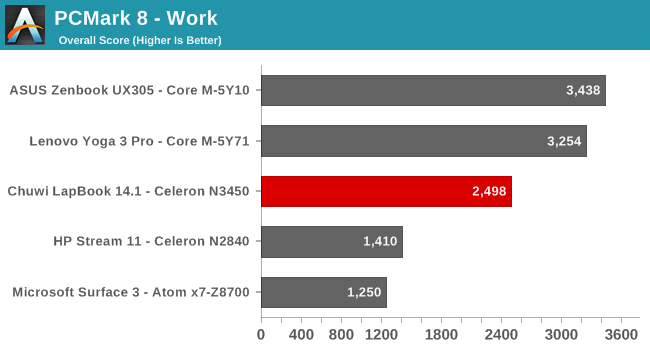

PCMark is an all-in-one benchmark, which tests all aspects of a system, including CPU, GPU, and storage. It tries to use real-world tests, which will stress burst performance by the processor, as well as some more demanding longer duration tests. The new Goldmont cores, paired with Gen 9 graphics, have certainly moved the bar forward for Atom. The performance is quite a bit better than the HP Stream, although that is just a dual core device, but it’s also well ahead of the Microsoft Surface 3, which has a quad-core Cherry Trail X7-Z8700, but with a 2-Watt SDP compared to the 4-Watt SDP in the Apollo Lake. But even if you compare it to the Lenovo Yoga 3 Pro, with Core M-5Y71, the Chuwi offers about 70% of the performance of this in PCMark 8. Granted the Yoga 3 Pro was not the most performant Core M system, but still, it’s a decent result, when you consider the Chuwi costs about 25% of that device.
Cinebench
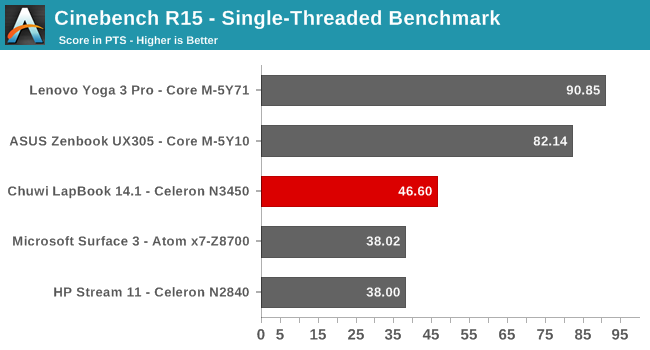
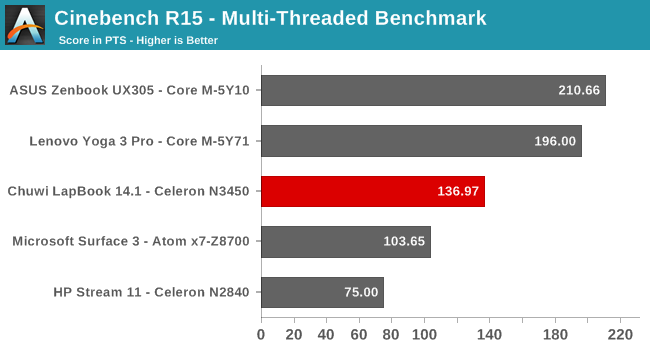
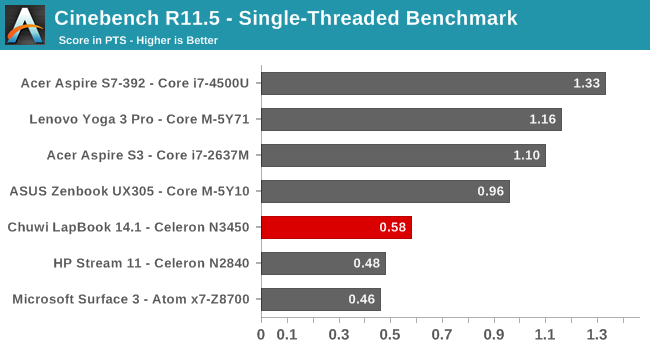
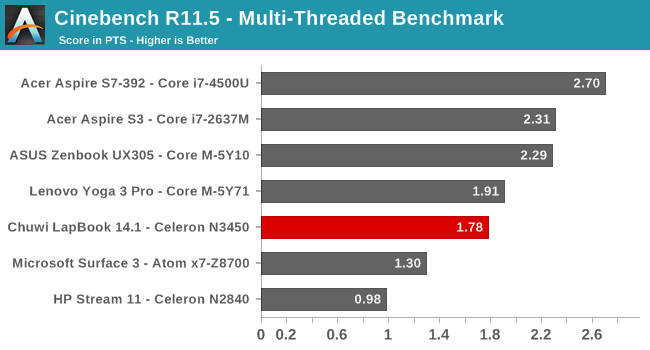
Cinebench is a pure CPU test, with higher performance cores, and multiple cores, giving much more performance. Here we can see the jump in single-threaded performance from the HP Stream 11 with it’s Bay Trail-M Silvermont cores, and the Chuwi LapBook with it’s Goldmont cores. Of course, the jump is even higher on the multi-threaded tests, since the Chuwi has a quad-core CPU rather than the dual-core in the HP Stream 11. It’s tougher to get a proper picture compared to the Airmont powered Surface 3, since that tablet SoC has half the scenario design power, but, the performance over the X7-Z8700 is significant. Once again, the Core M powered devices walk away from Atom here, as do the older higher TDP Core i7 in the two Acer models.
x264

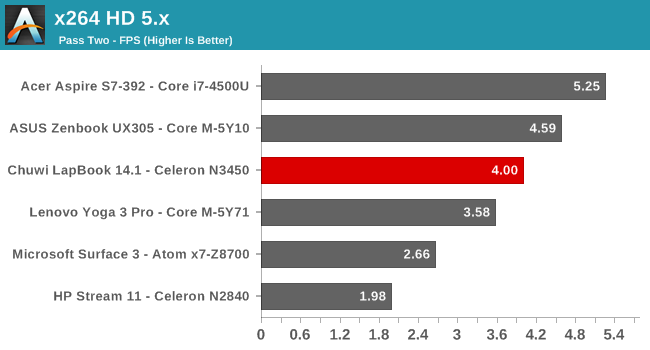
Much like Cinebench, x264 encodes a movie using the CPU, so this is a pure CPU test. The results are also much the same as Cinebench, but it’s interesting to note the Chuwi LapBook has passed the Core M powered Lenovo Yoga 3 Pro on pass two. The Yoga 3 Pro had some serious thermal issues, and Lenovo chose to limit the CPU temperature despite having a fan in the device, but it’s still impressive to see a Goldmont CPU perform better than a Broadwell CPU. Here the Chuwi LapBook scores 87% of the ASUS UX305, which was a solid performing Core M machine, despite it having the slowest Core M available in the Broadwell era.
Web Results
Testing the web performance is important because it’s arguably the most-used application on any PC. It’s worth pointing out again that all of our web performance testing prior to Windows 10 was done on Google Chrome, and the browser can have a more significant impact on the overall score than the CPU. When Microsoft Edge came along, offering performance that equalled or passed Chrome, we made the switch back to the stock browser. The exception here is the Acer Aspire S7-392, which was tested with Internet Explorer. Take these scores with that knowledge.
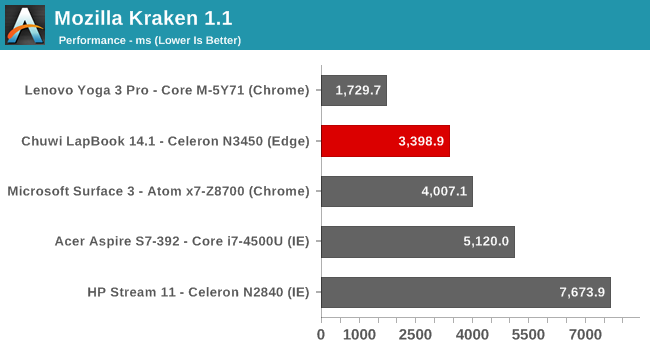
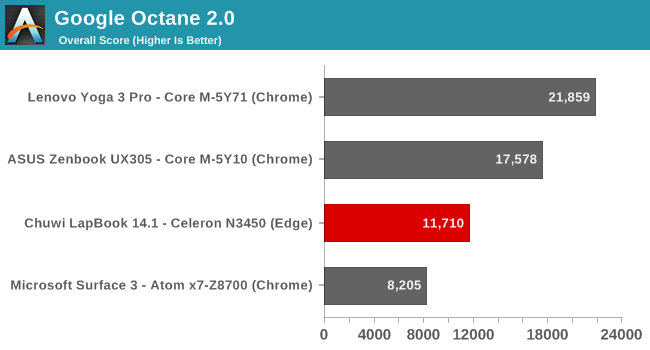

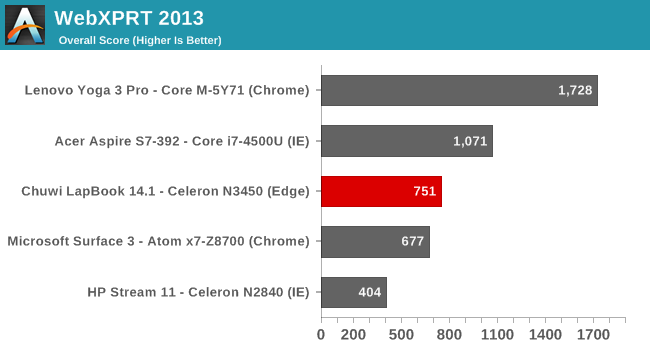
In all the tests, the Chuwi outperforms the Microsoft Surface 3’s Atom CPU, and is much quicker than the HP Stream 11, even with the browser differences. It can’t compete here with Core M, especially the Yoga 3 Pro which has the highest boost frequency, but compared to older Atom devices, it’s a nice step forward.
CPU Conclusion
It remains to be seen what will happen to Atom going forward, but for now, we can take a look at the latest Intel Apollo Lake platform with a quad-core Goldmont CPU. The step forward with Goldmont is significant, which bodes well for the platform, but it’s difficult to say if this will be enough with increased competition coming in the near future. Day to day use of the Chuwi LapBook was typical of any Atom powered device, in that it feels a bit slower than I’m used to, but the experience is not terrible. The fact that it provides about 70% of the performance in PCMark 8, compared to the Yoga 3 Pro, is quite remarkable, for a device that costs less than 25%. This would be difficult to use as a main computer for anyone, but if you need a portable computer on the cheap, the performance is not too bad.










75 Comments
View All Comments
BrokenCrayons - Friday, March 10, 2017 - link
Here's a link to a reviewer that tested the Lapbook with Ubuntu:http://www.cnx-software.com/2017/02/07/installing-...
The results look promising.
tipoo - Friday, March 10, 2017 - link
If I could don my tin hat for only a few seconds...Has anyone ever looked at the outbound traffic on these lesser known Chinese designed electronics? There was some controversy with Xiaomi router traffic even iirc.
BrokenCrayons - Friday, March 10, 2017 - link
A quick search didn't turn up anything. I don't think they're selling in large enough numbers to attract a lot of interest in sniffing their outbound traffic. It's a reasonable concern, but I don't think Chuwi would actively attempt to perform mass data collection. That's a pretty widely cast net that wouldn't reap much value because you're probably looking at largely home users. The data collection would be almost entirely uninteresting. Maybe some social networking, shopping and general web browsing, someone's hidden inappropriate photos and videos...that kind of thing isn't worth a lot unless you have a specific target in mind and in that case its more prudent to isolate that individual rather than everyone buying your products. Probably the best you'd get is access to someone's personal finances and a deep enough investigation would do a lot of damage to business interests. It's really worth more to establish a good brand reputation and land decent numbers of sales than it is to go through the trouble of getting one or two generations of hardware out there to a small number of people that probably are collectively deep in debt and have little liquid cash.fanofanand - Monday, March 13, 2017 - link
I think the concern would lay more on the government's involvement (The Chinese government is involved with virtually all exported electronics). I agree with every single thing you wrote, but Chinese businesses don't all exist for the sole purpose of making money.Bullwinkle J Moose - Friday, March 10, 2017 - link
Good point tipooThis article just today and all the turmoil at Samsung and S Korea makes me think we should be looking out for malware popping up in other places
Even places we have considered to be quite reliable up till now
https://arstechnica.com/security/2017/03/preinstal...
Things seem to be escalating but I'm sure the CIA will put a start to any malware threats to this Country (LOL)
Murloc - Saturday, March 11, 2017 - link
to make such low costs devices you buy standard chips so I don't think they can put anything in it.If chinese-designed chips have espionage software in them, then a bunch of the network infrastructure we rely on is bugged because huawei is everywhere in them. Also phones that use mediatek devices.
So worrying doesn't make sense, also because it's well-known from the various leaks and stuxnet that the NSA and the CIA and mossad don't need hardware to snoop or damage critical infrastructure so the chinese don't either.
Meteor2 - Friday, March 10, 2017 - link
Nice review of a nice machine.Good to read about how Goldmont finally played out. MS must've been pissed when Intel cancelled Broxton, but I imagine it's now Intel's turn with Windows on 835 coming. It's a shame Intel did what they did as Goldmont appears to be good silicon.
aryonoco - Friday, March 10, 2017 - link
The main competition in this price category is Chromebooks.The fact that you are pitting this device in your comparisons against a Yoga 3 Pro and a Asus UX305, and not a single Chromebook, says all that needs to be said about the sorry state of AT these days.
Sure, I miss Anand & Brian, but when they left we got Jarred Walton Andrei Frumusanu, who at least knew what they were talking about. Ryan, these new writers you have hired do not stack up.
Ian Cutress - Saturday, March 11, 2017 - link
To clarify an obvious error: Jarred was here 10 years, and both Andrei and Brett were here well before Anand left. Brett has been one of our freelance editors for over two years and attends events such as CES and Build as our Senior Laptop Editor. If you dislike the context of this review, sure, I'll grant you that opinion, but he has a large body of great work under him already. He's not new, he knows the score.On the testing front, it's a factor of what we get in for testing at any given time. Ultimately 90% of the time vendors want us to test their premium units, not something low cost. And there's a thousand low-cost options out there to potentially compare them against. When you've got a freelancer with time for 6-10 reviews a year, most of those will be high-end premium reviews. So if something interesting comes along, even at a super low price point, you compare against what you can or have at the time.
Which in this case, the HP Stream 11 is the perfect comparison point for all these benchmarks. The Yoga/Surface are added to show the comparison to what a high-end notebook investment would be, which users always want to know without having to dig through our results database. We do have some Chromebooks in our database, but they are old. We haven't tested one in a long while (so we don't have one in for retesting), and they were all done by a different reviewer over 1000 miles away at the time. Most of the Chromebooks are Atom based anyway, which is why the HP Stream is still a relevant comparison. Heck, I even recommended the Stream 11 to someone I know a couple of weeks ago, and she loves it (especially now there's a 360-degree hinge version).
fanofanand - Monday, March 13, 2017 - link
I get what the OP is saying but it is misguided in this case. Brett's reviews are solid. Some of the review product choices (case and PSU reviews) have been questionable but other than mobile reviews I haven't seen a real decline in the quality of Anandtech's journalism. Yes, they have had some major misses in the last year (especially in the GPU space) but what they have actually written has been fairly solid content.